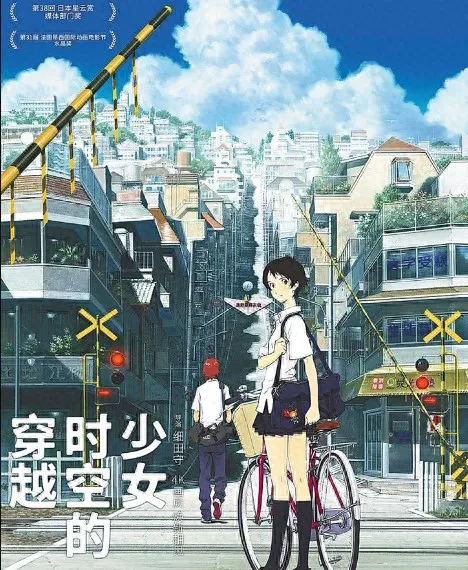The Girl Who Leapt Through Time: A Timeless Anime Classic
As the saying goes, time flies like an arrow. The “arrow” here describes the swift passage of time, subtly hinting at a sense of regret that “time and tide wait for no man, and holidays are spent dispelling worries.” But what if you had the superpower to travel through time? Would this ability change your current life? The animated film The Girl Who Leapt Through Time seeks to answer these very questions. Recently, this anime film has been re-released in theaters nationwide. It’s worth noting that this isn’t a “new movie,” but a “classic” from 2006, now presented in a 4K high-definition remastered version.

The Girl Who Leapt Through Time Movie Poster
From Literature to Animation: A Classic Reborn
The Girl Who Leapt Through Time has cemented its place as an animated film classic. Interestingly, the film is adapted from a novel of the same name, which is even more of a “classic” – Yasutaka Tsutsui’s The Girl Who Leapt Through Time.
Yasutaka Tsutsui, often hailed as the “Godfather of Japanese science fiction,” has created numerous popular works, with The Girl Who Leapt Through Time being one of his most representative. Although the novel falls squarely into the young adult genre and exudes a youthful vibe, it’s actually much older than one might imagine. It was serialized in a magazine from November 1965 to May 1966. Over the years, the novel has maintained a significant influence, being adapted into films and television series multiple times, including both live-action and animated versions. This speaks volumes about the enduring artistic vitality of literary works across time.
The 2006 film, which premiered in Japan, became a classic in the animation world. Director Mamoru Hosoda rose to prominence as an animation director with this film, which is also considered one of his masterpieces. The film won the Best Animation Award at the 6th Tokyo Anime Awards, the Japan Academy Prize for Animation of the Year at the 30th Japan Academy Film Prize, and the Cristal Award at the 31st Annecy International Animated Film Festival. On China’s Douban platform, the film boasts a high score of 8.6, demonstrating its widespread acclaim and audience recognition.
In this regard, the film has become an unmissable classic in the history of world animation, a representative work of anime culture, showcasing a unique artistic charm. This unique charm is created through a narrative strategy that combines science fiction themes with a coming-of-age story.
The Sci-Fi Theme of Time Leaps
The story of The Girl Who Leapt Through Time is not complex. It primarily revolves around the lively high school life of 17-year-old Makoto Konno. Through a chance encounter, Makoto gains the ability to leap through time, allowing her to constantly travel through time. She uses this superpower to return to the past, resolving the troubles and confusions she encounters in her youth, and gaining profound insights into growing up during this pivotal summer.
Many researchers have pointed out that “girls” are a special type of character in Japanese anime culture, highlighting many of the problems and symptoms of Japanese society. In The Girl Who Leapt Through Time, Makoto is portrayed as an energetic and cheerful girl. As the central figure of the film, her actions form the main thread of the story, with all the plot points revolving around her. Her life is composed of love, friendship, and family, forming a complex interpersonal network. Her time leaps disrupt the original order of her life, leading to a series of chain reactions.
As a science fiction work, the film’s sci-fi elements are mainly embodied in the “time leap” setting. Compared to more “hardcore” science fiction writing, The Girl Who Leapt Through Time leans more towards a “soft sci-fi” approach, with “time” being the biggest draw of the film. Whether it’s the phrase “Times waits for no one” written on the classroom blackboard or Chiaki’s words to Makoto, “I’ll be waiting for you in the future,” the theme of time is emphasized. Between the past, present, and future, only science fiction can address this greatest mystery of life.
The Lightness of a Coming-of-Age Story
In the film, Makoto’s reasons for leaping through time are not for saving the world or other grand endeavors, but for the small things in her life. For the sake of friendship and love, she repeatedly performs “time leaps,” constantly returning to specific moments in the past. Whether it’s to escape or to save, she wants to give herself more chances to choose. From an adult perspective, such “time leaps” might seem trivial, a waste of superpower. But for Makoto, they represent her courage to confront linear time.
The Girl Who Leapt Through Time aims to express this energy and courage that comes from youthful life. The film’s appeal lies in its accumulation of campus elements, such as friendship, baseball, crushes, and confessions, as well as its depiction of the ambiguous and innocent feelings of youth. It evokes the audience’s beautiful memories of youth, with delicate and precise details that reflect the creators’ dedication and sincerity, generating empathy and resonance with the audience.
At the same time, although The Girl Who Leapt Through Time has a rather heavy theme of “time,” the overall style is lighthearted. The film highlights “light comedy” elements, with excellent control over pacing and emotions. For example, when Chiaki sincerely confesses his love to Makoto, she repeatedly avoids the confession by leaping through time. This scene is particularly endearing. The Girl Who Leapt Through Time possesses a lightness unique to the coming-of-age genre, creating a relaxing and healing summer atmosphere.